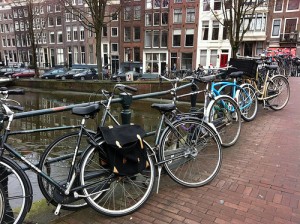Fietsen Posted by Karoly Molina on Jul 15, 2014 in Culture, Dutch Vocabulary
They say you never forget how to ride a bike.
I, like any other kid, learned to ride a fiets (bike) at a young age. I started with a tricycle, then a regular fiets with training wheels, and, finally, one Christmas morning a big kid bike appeared under the Christmas tree. Slowly but surely, I learned to ride my bike without my father guiding me from behind. I felt emancipated, free and only the wind could dictate my route. Sadly, I lived in a place where the 40 plus (Celsius) temperatures didn’t allow too much bike riding. After some time, the fiets was abandoned in the garage until my little sister was able to use it.
When I moved to the Netherlands, I immediately wanted to join the fietscultuur (bike culture). I bravely made my way into a fietswinkel (bike store) with my boyfriend certain that I would walk out, no, ride out just like any other Dutch person I had seen. Boy was I wrong! The nice old lady at the store let me take the fiets out back to test it out. I positioned myself, and, as soon as I had both feet on the trappers (pedals), I fell. My boyfriend, of course, laughed. I was devastated and embarrassed. I gave him the fiets and walked out leaving my dignity and pride on the floor where I fell. I swore I would not get on a fiets ever again!
In the Netherlands, it is inevitable and indispensible to ride a bike. My need to move around on my own pushed aside my pride. In December, with the help of my family, I re-learned how to ride a bike. At first, it was hard and I would wobble and lose control. Shortly after, I was able to make turns. Five months after my lessons, I finally have a fiets, and I am quickly learning to move around. I am no Dutchwoman who can juggle between the umbrella and cell phone while riding at record speeds; I am content if I can signal a turn.
Learning Dutch has been the same experience. I got on the Dutch language ride thinking it would be a smooth one, but it hasn’t been. There were days I swore I could communicate with everyone. Other days, I thought I would never learn and wanted to move as far away from the Netherlands as possible. However, like all fietsers (people who ride bikes) know, the only way to balance is to keep riding; I think the same applies for learning Dutch.
Therefore, I will keep on practicing both because I know deep down inside I will soon be able to ride a bike holding an umbrella, with my cat on the bagagedrager (carrier) and texting my mom a selfie all the while greeting a neighbor Hoi Hoi!
Useful Vocabulary
fiets– bike
fietsen– to bike or plural for bike
de bel– bell
de trapper– pedal
het stuur– handlebars
het zadel– seat
het wiel– wheel
de bagagedrager– carrier

Build vocabulary, practice pronunciation, and more with Transparent Language Online. Available anytime, anywhere, on any device.
About the Author: Karoly Molina
Since I was a little girl, I was fascinated with languages and writing. I speak English, Spanish, Italian, Dutch and a little bit of French. I am a writer, reader, language teacher, traveler, and a food lover! I now live in The Netherlands with my husband Riccardo, our cat Mona, and our dog Lisa, and the experience has been phenomenal. The Dutch culture is an exciting sometimes topsy-turvy world that I am happily exploring!




